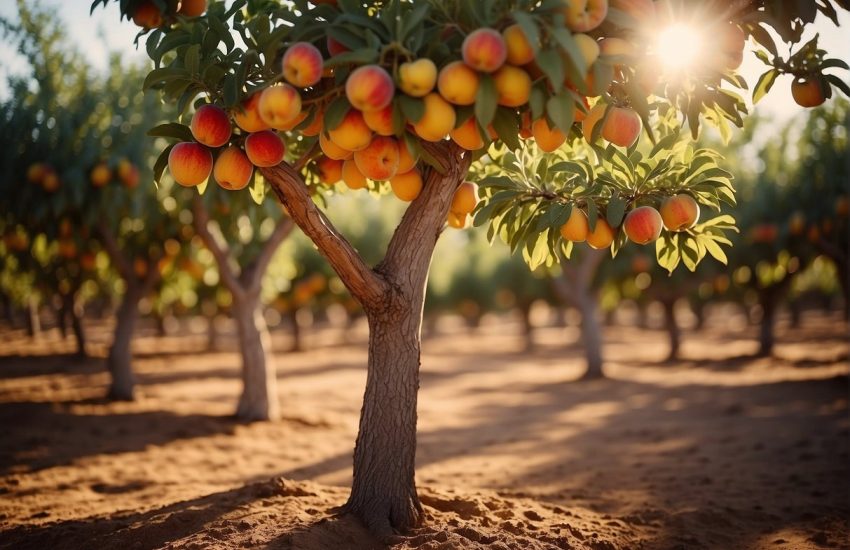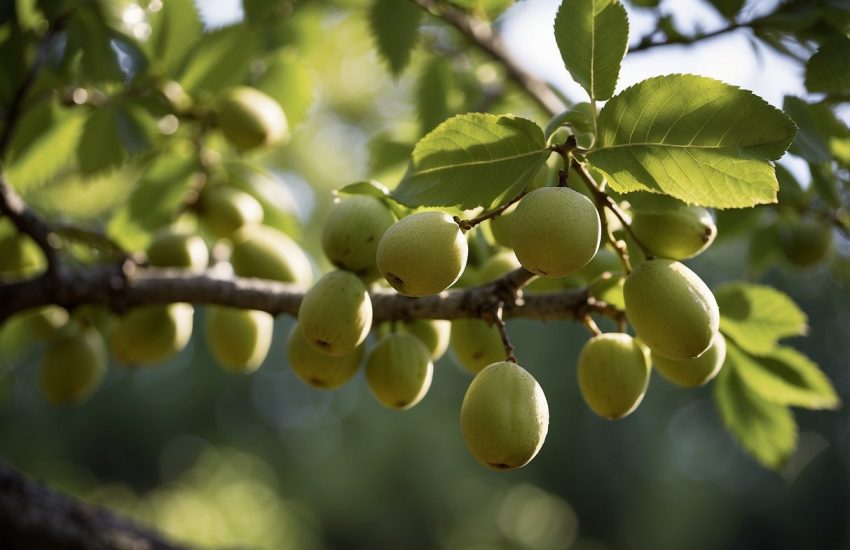Best Cherry Trees for Zone 6: Top Picks for Optimal Growth and Fruit Production
Cherry trees are a popular addition to gardens and orchards, offering both ornamental beauty and delicious fruit. However, not all cherry trees are created equal, especially when it comes to climate. Zone 6, which covers a large portion of the United States, has a particular set of weather conditions that can challenge even the hardiest of trees. This article will explore the best cherry trees for zone 6, taking into account factors such as cold tolerance, disease resistance, and fruit quality.

One of the most important considerations when choosing a cherry tree for zone 6 is its ability to withstand cold temperatures. Cherry trees that are not well-suited to colder climates may suffer from frost damage or fail to produce fruit altogether. Additionally, disease resistance is another crucial factor to consider, as many cherry tree varieties are susceptible to pests and fungal infections. By selecting a cherry tree that is naturally resistant to common diseases, gardeners and orchardists can save themselves time and money on treatments and maintenance.
Finally, while hardiness and disease resistance are important, many people choose cherry trees for their fruit. When selecting a cherry tree for zone 6, it’s important to consider the quality and flavor of the fruit it produces. Some varieties may be better suited to baking or canning, while others are ideal for fresh eating. By taking all of these factors into account, gardeners and orchardists can choose the best cherry trees for zone 6 and enjoy a bountiful harvest year after year.
Selecting the Right Cherry Trees for Zone 6
When it comes to selecting cherry trees for Zone 6, it’s important to choose varieties that can withstand the region’s cold winters and hot summers. Here are some things to consider when selecting the right cherry trees for your Zone 6 garden.
Understanding Hardiness Zone 6
Zone 6 has an average minimum winter temperature of -10 to 0 degrees Fahrenheit. This means that cherry trees grown in this area must be able to tolerate cold temperatures and frost. It’s important to choose cherry tree varieties that are hardy to Zone 6, as trees that are not hardy to this zone may not survive the winter.
Popular Cherry Tree Varieties for Zone 6
Sweet cherries, such as the Bing variety, are a popular choice for Zone 6 gardens. Bing cherries are known for their large, dark red fruits that are sweet and juicy. Another popular sweet cherry variety for Zone 6 is the Lapins cherry, which produces large, firm, and flavorful fruit.
Sour cherries, such as the Montmorency variety, are also a good choice for Zone 6 gardens. Montmorency cherries are known for their tart flavor and are often used for making pies and preserves. The Stella cherry is another popular sour cherry variety for Zone 6 gardens, producing large, dark red fruit that is both sweet and tart.
Considerations for Tree Size and Space
When selecting cherry trees for your Zone 6 garden, it’s important to consider the size and space requirements of the tree. Dwarf cherry trees, such as the Stella and Lapins varieties, are a good choice for smaller gardens or for those who want to grow cherry trees in containers. These trees typically reach a height of 8 to 10 feet and are easy to maintain.
For larger gardens, standard cherry trees may be a better choice. These trees can grow up to 30 feet tall and require more space to grow. It’s important to choose a location for your cherry tree that receives full sun and has well-draining soil.
In conclusion, selecting the right cherry trees for Zone 6 requires careful consideration of hardiness, variety, and size. By choosing the right cherry tree for your garden, you can enjoy delicious fruit for years to come.
Planting and Caring for Your Cherry Trees

Cherry trees are a beautiful addition to any garden, and with proper care, they can provide you with delicious fruit for many years. Here are some tips for planting and caring for your cherry trees in zone 6.
Best Time for Planting Cherry Trees
The best time to plant cherry trees is in the early spring, just before they begin to bud. This allows the roots to establish themselves before the tree begins to put energy into growing leaves and fruit. Fall planting is also an option, but it’s important to plant early enough so that the tree has time to establish roots before the ground freezes.
Soil Preparation and Requirements
Cherry trees prefer well-draining soil that is rich in organic matter. Before planting, it’s important to prepare the soil by digging a hole that is twice as wide and deep as the tree’s root ball. Mix in some compost or well-rotted manure to improve the soil’s fertility.
Watering and Mulching Practices
Cherry trees need consistent watering, especially during the first few years of growth. Water deeply once a week, and more frequently during hot, dry weather. Mulching around the base of the tree can help to retain moisture and suppress weeds. Use organic mulch such as wood chips or shredded leaves, and avoid piling the mulch up against the trunk of the tree.
Pruning and Maintenance Tips
Pruning is important for maintaining the health and shape of your cherry tree. Prune in the late winter or early spring before new growth begins. Remove any dead, diseased, or crossing branches, and thin out the center of the tree to improve air circulation. Avoid pruning during the summer months, as this can stimulate new growth that may not have time to harden off before winter.
Fertilizing is not usually necessary for cherry trees, but if you notice slow growth or yellowing leaves, you may want to apply a balanced fertilizer in the spring. Follow the manufacturer’s instructions carefully, and avoid over-fertilizing, as this can damage the tree’s roots. With proper care, your cherry tree will thrive and provide you with beautiful blossoms and delicious fruit for many years to come.
Protecting Cherry Trees from Pests and Diseases
Cherry trees in zone 6 can be susceptible to various pests and diseases that can damage or even kill the tree. It is important to take preventive measures to protect the tree from these threats.
Common Pests and How to Manage Them
One of the most common pests that can affect cherry trees is aphids. These tiny insects can suck the sap from the leaves and stems, causing the tree to weaken and become more vulnerable to other pests and diseases. To manage aphids, one can use insecticidal soap or neem oil. These products can be sprayed on the tree to kill the aphids without harming beneficial insects.
Another pest that can cause damage to cherry trees is caterpillars. These can eat the leaves and fruit, causing significant damage to the tree. To manage caterpillars, one can use Bacillus thuringiensis (Bt), a natural bacteria that kills caterpillars but is harmless to humans and other animals.
Disease Prevention and Control
Powdery mildew is a common disease that can affect cherry trees, especially in humid environments. This disease appears as a white powdery coating on the leaves and can cause them to turn yellow and fall off. To prevent powdery mildew, one can ensure good air circulation around the tree and avoid overhead watering.
Netting can be used to protect cherry trees from birds, which can eat the fruit and cause damage to the tree. The netting should be placed over the tree before the fruit begins to ripen and removed after the harvest.
Overall, taking preventive measures to protect cherry trees from pests and diseases can help ensure a healthy and productive tree. Regular inspection and prompt action can help to control and manage any issues that may arise.
Harvesting and Enjoying Your Cherries

Cherry trees are a great addition to any garden or orchard. Not only do they provide beautiful blooms in the spring, but they produce sweet and delicious fruit in midsummer. When it comes to harvesting and enjoying your cherries, there are a few things to keep in mind.
Determining the Right Time to Harvest
Knowing when to harvest your cherries is crucial to getting the best flavor and texture. Sweet cherries are typically ready to harvest in mid to late summer, while sour cherries are ready a few weeks earlier. The best way to determine if your cherries are ready to be picked is to taste them. Ripe cherries will be sweet and juicy, while unripe cherries will be sour and firm.
Another way to determine if your cherries are ready to harvest is by their color. Sweet cherries will be a deep red color when they are ripe, while sour cherries will be a bright red color. If you’re not sure if your cherries are ready, you can also gently squeeze them. Ripe cherries will be slightly soft to the touch.
Methods for Picking and Storing Cherries
When it comes to picking cherries, it’s important to be gentle to avoid damaging the fruit or the tree. One method is to hold the stem of the cherry and gently twist it until it comes off. Another method is to use a pair of scissors or pruning shears to cut the stem close to the cherry.
Once you’ve harvested your cherries, it’s important to store them properly to ensure they stay fresh. Sweet cherries can be stored in the refrigerator for up to a week, while sour cherries can be stored for up to two weeks. You can also freeze cherries for later use by removing the stems and pits and placing them in a freezer-safe container.
In hardiness zone 6, cherry trees can be a great addition to any fruit tree collection. With proper care and attention, you can enjoy sweet and delicious cherries for years to come.


